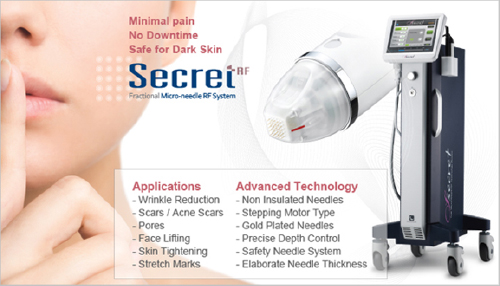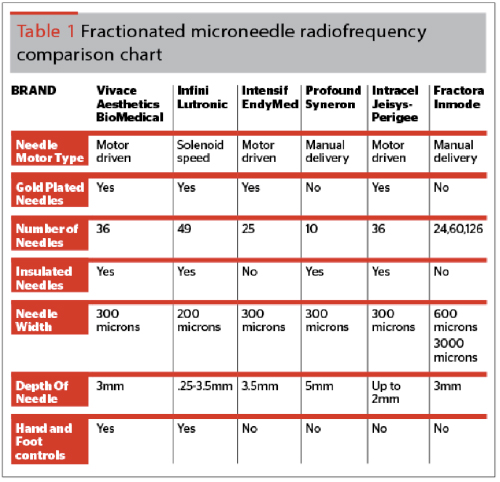Staff Writer, TMN Jul 20, 2018 7 years, 4 months, 1 week, 1 day, 22 hours, 30 minutes ago
One of the most promising new technologies for aesthetic treatments is the combination of two methods previously used individually for skin rejuvenation, microneedling and radiofrequency. This combination therapy, known as fractionated radiofrequency, is effective for improvement in acne and acne scars, as well as fine lines and wrinkles, both on and off the face. It can also be used for all skin types and is associated with minimal downtime and few complications.
Over the past 20 years, there has been great interest in the use of energy-based technologies to improve the appearance of the skin. CO
2 laser resurfacing is still considered the most effective modality for skin rejuvenation, but it is associated with significant downtime and a high risk of complications. In addition, it cannot be used for treatments off the face. Fractionated laser resurfacing, which was subsequently developed, was associated with faster recovery and fewer complications than fully ablative laser. Unfortunately, it could not provide the rejuvenation results possible with fully ablative lasers.
Radiofrequency technology was then developed for skin rejuvenation; it has been used for many years to improve skin laxity, rhytids, and acne scarring. This technology works differently than laser, as it uses tissue resistance within various layers of the skin to transform RF energy into thermal energy. This then causes collagen contraction and stimulates new collagen production. An advantage to RF over laser is that it should also be safe for all skin types since no light is emitted into the skin to stimulate melanin directly. There are both monopolar and bipolar radiofrequency systems available, and each has its limitations. Although there was initial excitement about RF, the author believes clinical results have been modest. Attempts to increase the electrothermal damage in the dermis created hotspots at the level of the epidermis, necessitating aggressive cooling to prevent epidermal damage and fat necrosis. Without sufficient thermal damage delivered to the mid and deep dermis, there was no significant skin tightening.
Microneedling has been used for many years for skin rejuvenation. The fine needles cause direct trauma by stretching the skin as the needles penetrate. This initiates a repair process that stimulates fibroblasts for new collagen production. It has been used for acne scars, alopecia, stretch marks, and wrinkling. In addition, the needles create channels that allow for direct delivery of topical medications applied to the skin. It is considered safe for all skin types, with little risk of post-inflammatory pigmentation. There are many devices available for microneedling, including some for at-home use.
Fractionated radiofrequency
Radiofrequency and microneedling were subsequently combined in an attempt to enhance the results that could be achieved with either one alone. The combination technology creates fractional radiofrequency coagulation of dermal collagen and results in immediate collagen contraction. It also stimulates a natural healing response which leads to the replacement of damaged connective tissue with new healthier skin.
Efficacy and clinical indications
As early as 2009, Hamtash et al. looked at patients 10 weeks after treatments using five microneedle pairs with bipolar RF. All patients showed increased elastin and collagen content. In 2012, Cho et al. report
ed clinical improvement in acne scars and facial pores. Another study demonstrated significant improvement in acne scars in all skin types. While Kim et al. also reported improvement in acne vulgaris with fractional radiofrequency microneedling. In this report, inflammatory lesions responded better than non-inflammatory lesions.
This combination technology has also been shown to be successful in treating primary axillary hyperhidrosis. After three sessions, there was a significant improvement in the hyperhidrosis disease severity scale on the treated side in comparison with the control side.
New technology is always being sought to treat fine lines, wrinkles, and skin tightening. Several studies have been completed looking at these concerns with the use of fractionated radiofrequency. In 2013, Kim et al. used microneedle radiofrequency to treat periorbital wrinkles of 11 women, they had a 91% satisfaction rate with the treatments. Lee et al. reported in another study for periorbital wrinkles in 2015, they looked at 20 patients with Fitzpatrick skin types IV–V. All patients noted improvement in their wrinkles by the end of the study.
The channels created by the needles remain open for up to several hours after treatment. This allows topically applied medications to penetrate to deeper levels of the dermis. The author understands there are currently several studies are underway looking at the use of this technology with topically applied 5-FU and steroids for improving scars.
Advantages over other methods
There are some advantages to RF over lasers for treating the skin. Fractional lasers were often used to treat acne and acne scarring. A limitation in treating acne scarring with fractional lasers has been the risk of hyperpigmentation, particularly in darker Fitzpatrick skin types. Radiofrequency energy is not specifically absorbed by melanin, which should decrease the risk of post-inflammatory hyperpigmentation, and the energy can be delivered by the needles at precise depths. This makes fractionated RF an attractive alternative modality for treating acne scarring.
Both RF and fractional lasers have been shown to stimulate collagen production which will help decrease wrinkling and tighten the skin. Radiofrequency has the added advantage of increasing elastin density which can aid in additional skin tightening.
Another major advantage of this technology over ablative laser resurfacing is that by adjusting needle depth and energy levels, it can be done in areas other than the face. In 2016, Clementoni et al. reported on fractional radiofrequency in the treatment of mild to moderate laxity of the lower face and neck; they treated 33 patients and noted a 28% reduction in the cervicomental angle, with 87% reported patient satisfaction.
Excellent improvement in neck wrinkles can be seen after microneedle with RF as shown in
Figure 1. These results are difficult to obtain with laser resurfacing due to the risk of scarring in non-facial tissue.
Complications and side-effects
In the author’s experience of administering microneedling radiofrequency, the treatments are perceived as uncomfortable, so topical anesthesia is applied to the area to be treated at least 1 hour before the session. It is important to clean the skin thoroughly before treatment, as any topical products will be pushed into the dermis with the insertion of the needles. Treatment protocols for these machines usually recommend doing three sessions, one month apart. There is no pain after the treatment is completed. Most patients have some mild erythema and edema for 1–3 days. Bruising can occasionally occur with the deeper needle insertions. The use of insulated needles should eliminate the need for topical cooling during the treatments since it bypasses the epidermis. Many providers will apply topical agents after the treatments to improve results as they can penetrate into the microneedle channels. This can include growth factors and PRP.
Complications are minimal; some patients may develop milia and will need some oral antibiotics if this occurs. There was one report of an allergic granulomatous reaction in 3 patients. Each patient had a moisturizer applied prior to treatment, and it was felt that this was a hypersensitivity reaction to micro-injection of the moisturizer. Some patients may develop post-inflammatory hyperpigmentation which should be treated with topical bleaching agents.
There are several different companies that now offer machines for this technology. One of the biggest differences in machines is whether the needles are insulated or non-insulated. The insulated needles allow the energy to be delivered to precise depths with only slight mechanical injury to the epidermis. This should help to decrease the risk of hyperpigmentation. This delivery of heat to the deep dermis is similar to non-ablative resurfacing modalities. With non-insulated needles, the heat is delivered along the whole length of the needle. This will, therefore, cause thermal damage at both the deep levels and the epidermis. This would be more similar to the damage profile seen with fractionating ablative resurfacing.
Available options
There are currently several options available for fractionated RF. All differ slightly in their specifications, but clinical studies support their efficacy.
Infini by Lutronic uses a system with 49 insulated needles. They are 200 microns in diameter and taper to a very sharp 20-micron tip. The depth can be set from 0.25 mm to 3.5 mm depending on the area to be treated. In addition to depth, the provider can adjust energy power level and exposure time. Several studies have been done showing improvements in acne scarring and skin laxity using this device. Clinical slides and personal correspondence have also reported Infini to be effective in skin tightening off the face, and for axillary hyperhidrosis.
Intensif by Endymed uses 25 non-insulated needles of 300 microns each. These can penetrate from 0.1 to 3.5 mm in depth. Modest improvement in acne scarring in almost all patients has been reported.
Fractora by InMode has a system that allows for the use of both insulated and non-insulated tips. They both use 24 and 60 pin tips with 600 or 3000 micron needles. Studies have been done with this technology reporting improvement in both acne scars and skin rejuvenation.
Syneron ePrime or Profound uses five pairs of bipolar 300-micron needles. The needles are 6 mm in length, and the last 3 mm are non-insulated. The needles are inserted at an angle, and a cooling plate is used to protect the skin surface. Long pulses are used (4–5 seconds) with high temperatures, which, in the author’s experience, can make the treatments uncomfortable. They have reported high patient satisfaction with the treatments for facial skin laxity.
Intracel by Jeisys uses 49 insulated 34 gauge needles. They use both monopolar and bipolar RF to deliver the energy to the tissue.
Vivace from
Aesthetics Biomedical is the newest machine offering this technology. It uses 36 insulated 300-micron needles, which can penetrate from 0.5 to 3.5mm. It then uses bipolar RF to heat the deep tissues.
A new portable microneedling pen powered by radiofrequency energy is the Eclipse MicroPen EVO. By changing a cartridge, one can select mechanical microneedling, RF-based microneedling or non-ablative bulk heating.
Conclusion
Fractionated microneedle radiofrequency treatments are effective for improvement in acne and acne scars, as well as fine lines and wrinkles, both on and off the face. The technique allows for precision in treatment through its ability to control the intensity of the energy, the depth of delivery, and the pulse duration. Insulated needles allow for sparing of the epidermis, and allows for its use in all skin types while decreasing the risk of post-inflammatory hyperpigmentation. Side-effects and downtime are significantly reduced compared to other energy-based devices used for skin rejuvenation.
There are multiple options now available with this technology. All differ slightly in their specifications, but they all have clinical studies which support their effectiveness. The author believes this is an exciting technology which will continue to have new exciting capabilities for rejuvenation both on and off the face.

